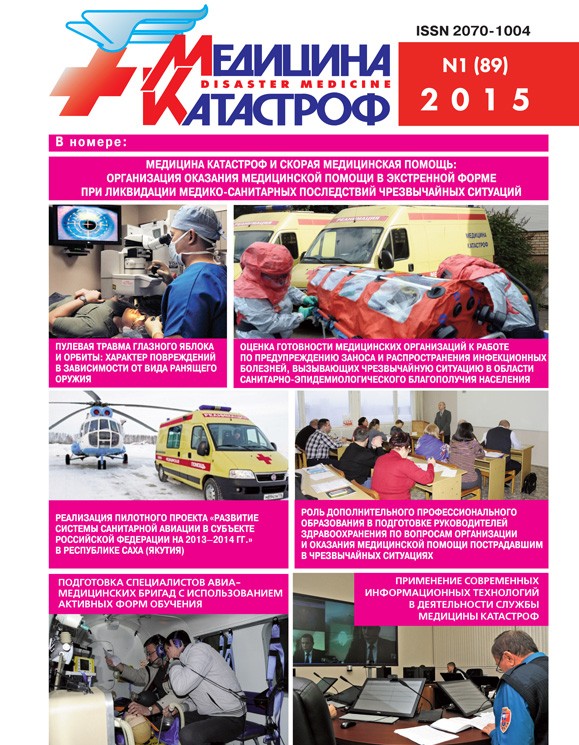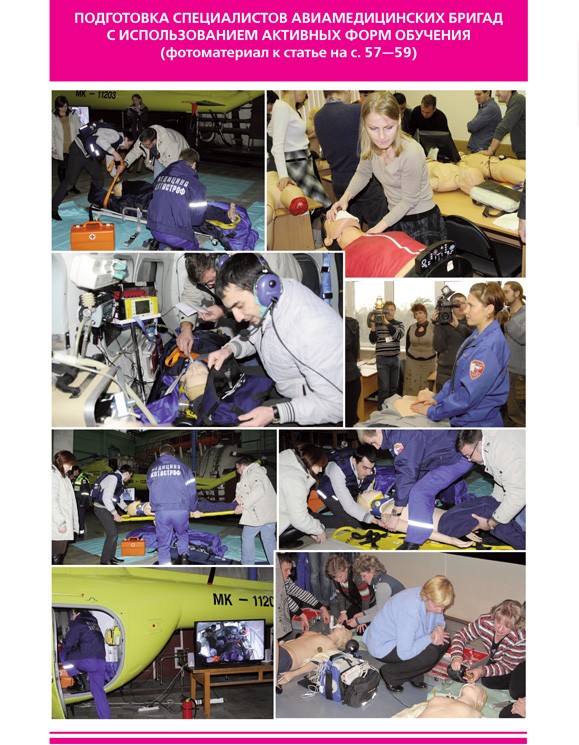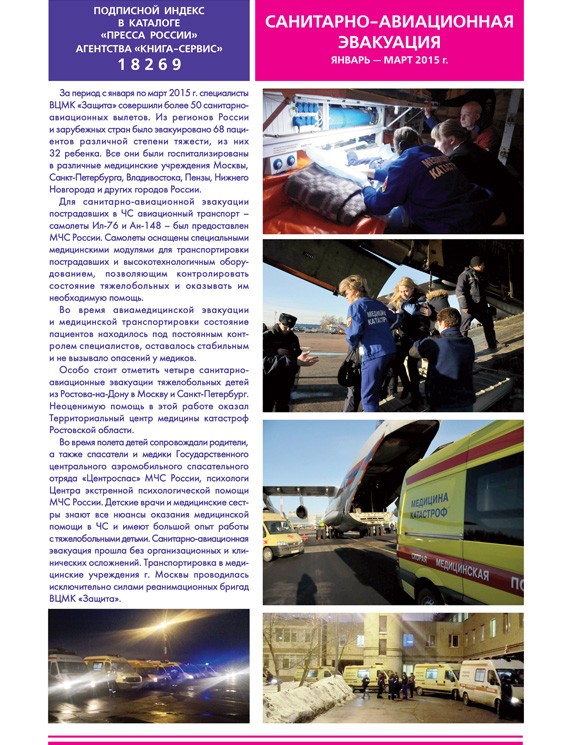DISASTER MEDICINE No. 1•2015 Download the journal
ORGANIZATION AND TACTICS OF DISASTER MEDICINE SERVICE
1. Goncharov S.F., Shilkin I.P. Use of Modern Information Technologies in Activities of Service for Disaster Medicine
Modern information technologies used by services for disaster medicine in the environment of medical care to victims of a large-scale emergency situation are presented. It is noted that medical care activity in an emergency situation zone is divided into three phases: victim isolation phase, rescue phase and recovery phase. Three main modes of use of telemedical technologies and equipment during recovery phase are discussed.
Key words: emergency situations, modern information technologies, recovery phase, rescue phase, service for disaster medicine, telemedical consultations, telemedical technologies, victim isolation phase
2. Evdokimov V.I. Emergency Situation Risk Metric Indices for Russian Federation in 2004–2013
The official data on emergency situations in the Russian Federation in 2004–2013 are analyzed.
The dynamic of reduction of number of emergency situations and their fatalities is defined. Some risks are calculated: a risk of finding oneself in an emergency situation within a time unit equal to a calendar year (R1), a risk of death in a single emergency situation (R2), an individual risk of death in an emergency situation within a time unit (R3), percentage of fatal casualties in number of deaths from all causes in a region (country) (R4). The dynamic of reduction of R3 and R4 indices.
Key words: emergency situations, individual risk of death in an emergency situation within a time unit, percentage of fatal casualties in number of deaths from all causes in a region (country), risk metric indices, risk of death in a single emergency situation, risk of finding oneself in an emergency situation within a time unit, Russian Federation
3. Goncharov S.F., Bystrov M.V., Tsinika G.V. Disaster Medicine and Emergency Medical Care: Organization of Emergency Medical Care Delivery in Liquidation of Medical and Sanitary Consequences of Emergency Situations
Problems of organization of emergency medical care delivery in liquidation of medical and sanitary consequences of emergency situations are discussed. The issue of cooperation of emergency medical services (facilities and formations of the Service for disaster medicine and of first-aid stations and teams) in everyday and emergency situation environments. The ways of integration of emergency medical services are shown in particular a suggestion is made on setting up of regional centers for emergency medical care and disaster medicine.
Key words: emergency medical care, emergency situations, first aid, integration of emergency medical services, regional centers for emergency medical care and disaster medicine (project), Service for disaster medicine, territorial centers for disaster medicine
4. Prostakishin G.P., Sarmanaev S.Kh. Preparedness of Medical Facilities and Formations for Emergency Medical Care Delivery to Casualties with Acute Chemical Injuries
An analysis of preparedness of medical facilities and formations for emergency medical care delivery to casualties with acute chemical injuries is presented. It is shown that the basis of preparedness of medical facilities and formations for liquidation of medical and sanitary consequences of chemical emergency situations is in adequate information on accident risks, but methods of prognosis of medical and sanitary consequences of this type of emergency situations have substantial shortcomings. It is noted that the issues of fast identification of chemical agents are not solved and their criteria of medical-biological (toxicological) character are not at hand though they are basic for judgement of danger of stay in contaminated area. A lack of centers for treatment of acute chemical injuries and low competence of their personnel are stated.
Key words: acute chemical injuries, casualties, chemical emergency situations, emergency medical care, medical facilities, medical formations
5. Samarin S.A., Babanin A.A., Potapov A.L., Novikov N.Yu., Kozlov M.A. Traumatism Analysis and Organizational Aspects of Medical Support of Victims in Mountains of Republic of Crimea
An analysis is done of casualties contingent in mountain areas of the Republic of Crimea, of the reasons for emergency situations, of seasonal fluctuations of traumatism, character of traumas and pathologies that necessitated call for rescuers. The main evacuation procedures to medical facilities are discussed. A short history of setting up and formation of rescue services of Crimea is presented. The importance of the issue at hand for the development of the tourist region is shown. A suggestion is made on elaboration of a program of survival gear provision and of additional training of personnel of specialized rescue services.
Key words: casualties, emergency situations, medical support, monitor and rescue service, mountain rescue service, mountains, Republic of Crimea, tourism, traumatism
6. Kochin I.V., Gorpenko S.V., Troshin D.A., Kurochka V.L. Preparation of Health Facilities for Activity in Terrorist Acts Threat and Measures for Personnel and Patients Security Assurance
An analysis is made of preparation of health facilities for functioning in environment of terrorist activity and of facility, personnel and patients security assurance measures. It is noted that the preparation of personnel for work in conditions of terrorist activity is carried out by way of a special training program. The performance is presented of duty doctor and health facility personnel under three levels of terrorist threat (increased, high, critical). An approximate composition of doctor-nurse teams for work in terrorist act zone and specialized medical care teams for organization and delivery of emergency medical care in the hospital are suggested.
Key words: doctor-nurse teams, emergency medical care, health facilities, patients, personnel, security assurance, Service for disaster medicine, specialized medical care teams, terrorist acts
CLINICAL ASPECTS OF DISASTER MEDICINE
7. Firsov S.A., Matveev R.P. Traumatism Associated with Alcohol Intoxication: Specifics of Peripheral Blood Circulation and of Endothelial Dysfunction
The influence is studied of alcohol intoxication on micro hemocirculation and endothelial dysfunction in casualties with severe traumas at acute period of traumatic disease. It is found that because of alcohol intoxication marked abnormalities of microhemoperfusion on stasic and paralytic types are evidenced, as well as high von Willebrand factor (VWF) level and higher endothelin-1 and NO.
Key words: alcohol intoxication, endothelial dysfunction, microhemoperfusion, peripheral blood circulation, traumatic disease
8. Petrova A.V., Tarasov D.A., Sklyarova T.P., Mekhant’eva L.E. Study of Functional Reserves of Organism in Context of Personality Orientation in Stress Situation
A problem is discussed of specialists adaptation for extreme conditions of functioning as well as their working environment, communicative and personality traits, levels of their nervous and mental stability, morality and functional reserves of organism.
Key words: adaptation for service activity, behavior regulation, communicative skills, emergency situation, functional reserves, morality, personality traits, stress situation
9. Strafun S.S., Tkach A.V., Plotkin A.V., Dvorsky A.G., Fedulichev P.N., Volkov A.S. Early Disease Detection Algorithm and Compartment Syndrome Management Tactics
Early disease detection algorithm and compartment syndrome management tactics are presented. Air-ion diagnostics – a new method of early disease detection and prognostication of compartment syndrome development is discussed.
Key words: air-ion diagnostics, compartment syndrome, early disease detection, treatment tactics
10. Neroev V.V., Bykov V.P., Kataev M.G., Kvasha O.I., Al-Daravish D.A. Bullet Trauma of Eye Ball and Eye Socket: Injury Character Depending on Wounding Weapon
The character of injury of eye ball and eye socket depending on wounding weapon and bullet type is presented. The management tactics of the contingent of casualties are discussed.
Key words: bullet trauma, eye ball, eye socket, injury character, wounding weapon type
ACTUAL PROBLEMS OF EMERGENCY CONSULTATIVE MEDICAL CARE PROVISION AND OF MEDICAL EVACUATION
11. Popov V.P., Kashevarova L.R. Perfection of Sanitary Aviation System in Sverdlovsk Oblast
The system is presented of organization of emergency consultative medical care delivery (sanitary aviation) in Sverdlovsk Oblast: inter-municipal centers, grading of the territory into three groups, introduction of infrastructure for light helicopters, drill of model of higher efficiency of emergency medical care delivery to road traffic accident victims and to patients due to stand-by duty of light helicopters at road-side stations of emergency medical care, training of specialists of air medical teams.
Key words: emergency consultative medical care delivery (sanitary aviation), air medical teams, emergency consultative medical care (sanitary aviation), grading of the territory, inter-municipal centers, light-class helicopters, Sverdlovsk Oblast
12. Sotnikov V.A., Olesov I.I. Realization of Pilot Project “Development of Sanitary Aviation System for 2013–2014 Period” in Republic of Sakha (Yakutia)
Data on results of realization of a pilot project of development of system of sanitary aviation in the Republic of Sakha (Yakutia) in 2013-2014 are presented. A detailed analysis is done of the state of emergency consultative medical care delivery in the Republic. It is demonstrated that a number of population health indices have shown positive tendencies as a result of measures taken by specialists of the Republican Center for Disaster Medicine and by government agencies within a framework of the pilot project.
Key words: emergency consultative medical care, medical evacuation, pilot project, Republic of Sakha (Yakutia), specialized medical care, system of sanitary aviation, target indicators
13. Antonyuk G.V., Kirsanov A.I., DvorskyA.G., Zolotaryova V.I. Activity of Emergency Consultative Medical Care Ward as a Part of Center for Disaster Medicine of Republic of Crimea
The activity of emergency consultative medical care ward functioning as a part of Crimean Republican Center for Disaster Medicine and First Aid is presented. The ways of optimization and directions of further development of the Ward: complement increase, introduction of telemetric technologies, setting up of a traumatology center, construction of first-aid station with a clinical facility in Simferopol are indicated.
Key words: Crimean Republican Center for Disaster Medicine and First Aid, emergency consultative medical care ward, emergency situations, medical evacuation
SANITARY-ANTIEPIDEMIC (PREVENTION) MEASURES IN EMERGENCIES
14. Suranova T.G., Chikova S.S., Shirokov A.Yu. Assessment of Preparedness of Medical Facilities for Activity on Prevention of Carrying and Spread of Infectious Diseases that Cause Emergency Situations in Area of Sanitary and Epidemiological Safety of Population
Methodology of assessment of preparedness of medical facilities for activity on prevention of carrying and spread of infectious diseases that cause emergency situations in the area of sanitary and epidemiological safety of population is discussed.
A list of criteria for quantitative assessment of level of facility preparedness for response to biological threats is suggested.
Key words: criteria for assessment of preparedness, emergency situations in area of sanitary and epidemiological safety of population, infectious diseases, preparedness of medical facilities, sanitary and antiepidemic measures
EDUCATION AND TRAINING OF PERSONNEL
15. Goncharov S.F., Sakhno I.I., Chernyak S.I., Baranova N.N., Nagavkin A.N. Role of Further Vocational Education in Training of Leading Health Cadres in Issues of Organization and Delivery of Medical Care to Victims in Emergency Situations
Role of further vocational education in training of leading health service cadres in issues of organization and delivery of medical care to victims in emergency situations is discussed. The approaches to elaboration of professional standards for heads of territorial centers for disaster medicine (with their further accreditation being considered) are substantiated on the basis of the best practice of such training.
Key words: accreditation, emergency situations, further vocational education, heads of health service management of subjects of the Russian Federation, heads of territorial centers for disaster medicine, medical directors (heads) of health facilities of hospital type, organization and delivery of medical care, professional competences, professional standards, Service for Disaster Medicine, training of leading health service cadres
16. Baranova N.N. Training of Specialists of Air Medical Teams with Use of Active Education Forms
Active forms of education are discussed that are used for training of specialists of air medical teams. A two-component simulation training course is presented.
Key words: active forms of training, cases, general professional competences, multifunctional man-simulators, sanitary aviation evacuation, simulation technologies, simulation training course, special professional competences, specialists of air medical teams




